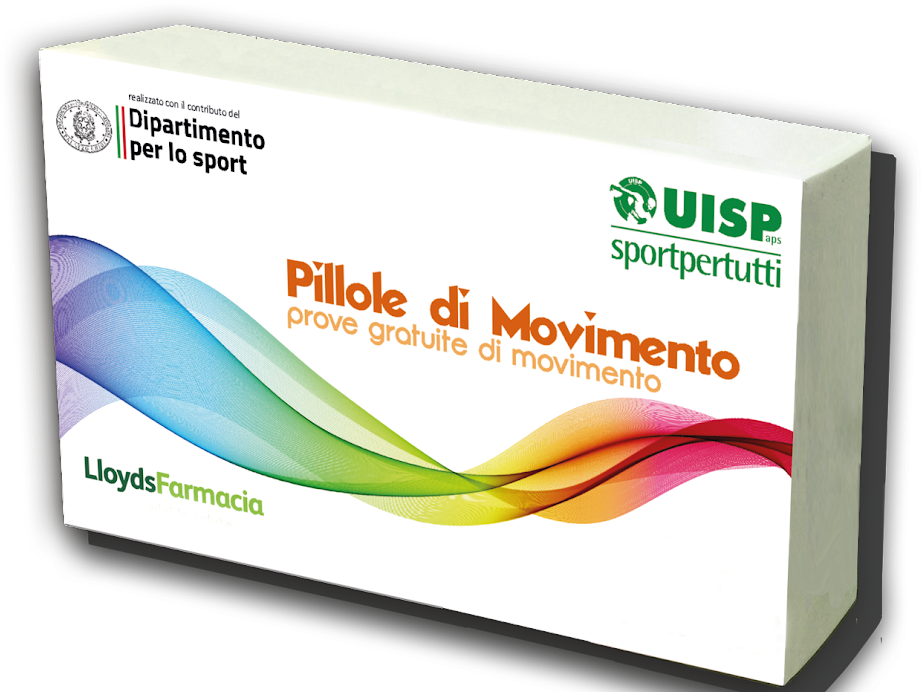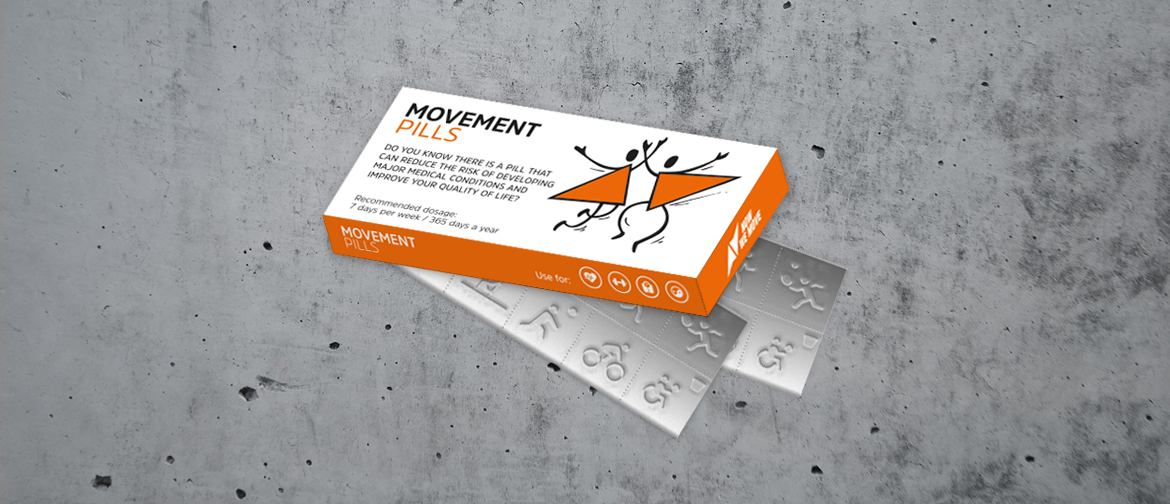MOVEment Pills: The story. The eye-catching boxes. The how-to toolkit.
MOVEment Pills: The story. The eye-catching boxes. The how-to toolkit.
Have you ever wondered whether doctors and medical practitioners can prescribe exercise to their patients? The answer is yes – and many are doing so today. And many more could be doing the same, but may not have the time, the skills or (unfortunately) the incentive to do so. Did you also know that physical activity promoters like yourself can nudge medical professionals and pharmacies to give out “exercise on prescription” in the form of MOVEment Pills? These are not pills to make you “go”, but to get up and go!
Benefits of using the MOVEment Pills:
- Lead to better academic performance among children and adults
- Reduce the risk of recurrent breast cancer by approximately 50%
- Reduce the risk of developing Alzheimer's disease
- Decrease the chance of becoming depressed
- Increase the chance of living longer
- Strengthen bones and muscles
- Release happy hormones
- Improve quality of sleep
- Help increase mobility
- Relieve stress
More and more evidence is emerging about the physical and mental health benefits of exercise and leisure. But time is still one of the biggest barriers preventing people from taking up regular physical activity. The clue to taking the first steps towards an active lifestyle is to break it down into “bite-sized” movements – like pausing quickly to take medicine or (in colloquial terms) to pop a pill.
At ISCA, we first developed our eye-catching MOVEment Pills boxes in 2015 (based on a concept created by our Italian member UISP, who has partnered with pharmacies across Italy to distribute its pill boxes). In this toolkit we’ll share the story of the idea and how to use it in your work as MOVE Agents who want engage more people in physical activities.

Our current MOVEment Pills package includes:
- MOVEment Pills boxes and physical activity inspiration blisters (fake “pills”)
- A patient information leaflet with “dosage” instructions (in English)
- YouTube playlists featuring 50+ short exercise videos for the Office, Home and Outdoors
- A letter template for MOVE Agents to approach potential partners
- Social media visuals, videos and messages
- Webpage under the NowWeMOVE campaign umbrella featuring all resources
Browse this how-to toolkit to learn more about this innovative tool, which can open doors to conversations with potential partners, enhance your media coverage, and engage people at your events by showing them the types of exercises that can be done in the same amount of time as it takes to make a coffee or tea.
Timeline
Exercise on prescription -> Exercise is medicine -> MOVEment Pills!
The idea of ‘exercise on prescription’ is not new, nor is it particularly controversial to suggest that medical practitioners can prescribe exercise as ‘medicine’ to help patients build physical and mental strength, fitness, prevent noncommunicable disease and aid their recovery. That said, it is still very much a work in progress. We traced the concept (and its evolution) back to the US in the 1970s…
1st Guidelines for Exercise Prescription?
Guidelines for Graded Exercise Testing and Exercise Prescription are published in America, and updated in 1980 and 1986: “The overall goal of the Guidelines is to promote a higher standard of practice in preventive and rehabilitative exercise programs, thereby affording effective and safe exercise opportunities for program participants … while at the same time not erecting barriers to participation.”
Preventive medicine will be health wave of 1990s!
“If the 1980s gave Americans concrete evidence of the benefits of proper diet and exercise, the 1990s will drive home the concept of preventive medicine, said the physician credited with focusing the nation’s attention on the advantages of aerobic exercise. ‘The ’90s will be the decade of prevention,’ said Kenneth H. Cooper.”
Swedish researchers trial Physical Activity on Prescription in primary health care
Swedish primary health care units conducted trials in 2001-2003, finding that “if a patient in primary health care needed physical activity preventively or for treatment of a disease and patient-centred motivational counselling found physical activity to be suitable, individualised physical activity could be prescribed.” The model has evolved and still exists today, but “lack of time, resources and knowledge among decision makers and professionals” are still major obstacles to implementation in 2022.
Exercise is Medicine becomes a trademarked initiative
“The initiative, Exercise is Medicine (EIM), started by the American College of Sports Medicine (ACSM) and the American Medical Association (AMA) in 2007, is ‘calling on all health care providers to assess and review every patient’s physical activity program at every visit’.”
UISP launches first Pillole di Movimento (MOVEment Pills) campaign

ISCA launches International version of MOVEment Pills
The European Initiative for Exercise in Medicine (EIEIM) is founded as an independent EIM centre

Intelligent Personalised eHealth Exercise Prescription?
“Exercise prescription … has the potential to be an important therapeutic agent for all ages in the prevention of chronic disease ... However, it is often poorly implemented, as clinicians lack the necessary knowledge and skills while participants have low adherence due to design defects (e.g. prescriptions fail to take individual willingness, the appeal of exercise, and complex physical conditions into account). Intelligent personalised prescription is thus worth exploring.”
UK government pledges £12.7 million towards ‘social prescription’ trials
“Social prescriptions, including walking, wheeling and cycling, will be offered by GPs as part of a new trial to improve mental and physical health and reduce disparities across the country, the government has announced today (22 August 2022).”
Why it’s important for many patients to keep MOVING.

Why it’s important for many patients to keep MOVING.
The myth that exercise is too risky or dangerous for people with pre-existing or new conditions, the elderly, people with disabilities, people with obesity or overweight, or patients recovering from serious illness can be a barrier for millions who could actually feel better if they moved more.
Medical practitioners may be reluctant to prescribe exercise to their patients, and the patients might feel that exercising is beyond their physical capacities. But growing research is showing how important it is to keep moving, with guidance and support, to maintain physical fitness and aid in the prevention of and recovery from adverse physical conditions.
Even the 1975 Guidelines mentioned that “exercise is a normal human activity and is relatively safe”, recommending that healthy people under the age of 45 could be prescribed exercise without physical testing or close monitoring. Those over 45 or with one or more risk factors (pre-existing conditions or disease), should, however, undergo a fitness assessment and be monitored when starting a new exercise programme, it states.
Prevent or improve
Potential benefits of prescribing physical activity to 5 target groups
The elderly
- Prevention or decreased risk: Non-communicable disease, site-specific cancers, hypertension, falls, dementia, all-cause and cardiovascular disease mortality
- Improvement or increase: Cardiorespiratory fitness, strength, muscle mass, balance, mental and physical wellbeing, cognitive health and rehabilitation after stroke, healthy blood pressure, social contact, sleep quality, quality of life
Source: Langhammer, Bergland & Rydwiik, 2018 ; WHO, 2022
Cancer patients
- Prevention or management: Side effects of treatment, recurrence, fatigue, lymphedema, inflammation, anxiety, depression, impaired mobility, up to 50% decreased risk of dying from the disease; decreases risk of developing colon, breast and endometrial cancers
- Improvement or increase: Immune system, metabolic function and digestion, mental and physical wellbeing, quality of life, physical function, balance, strength, healthy body weight, insulin sensitivity, chance of recovery
Source: Macmillan Cancer Support, 2012 ; World Cancer Research Fund International, 2018
People with disabilities
- Prevention or decreased risk: Type-2 diabetes, heart disease, weight gain, depression, anxiety, falls
- Improvement or increase: Mental and physical wellbeing, strength, flexibility, functional balance, endurance, longevity, independence, social contact, quality of life
Source: US National Centers for Disease Control and Prevention, 2022 ; WHO, 2022
People with obesity and overweight
- Prevention or decreased risk: Type 2 diabetes, heart disease, premature mortality, depression, further weight gain
- Improvement or increase: Cardiorespiratory fitness, metabolic rate, strength, quality of life, emotional health, sleep quality
Source: Pojednic, D’Arpino, Halliday & Bantham, 2022
Connect
Subscribe to ISCA newsletter for regular updates on our events, activities and opportunities in our network
You can unsubscribe at any time.


